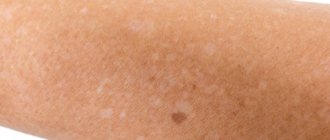Pigment spots are areas of the skin that have darkened for various reasons. They have a brown tint and are noticeably different in color from the surrounding tissues. Unlike skin changes caused by infections, injuries or fungi, age spots never become inflamed, so they are considered a purely cosmetic defect.
At the same time, in addition to deteriorating appearance, age spots cause other problems, often complicated by dryness and roughness of the skin, wrinkles, etc., which is why people try to get rid of them.
Causes of age spots
The color of human skin depends on the concentration of pigments. A lack or excess of melanin, carotene and other pigment substances leads to the formation of pigment spots of different colors and sizes. Discolored patches of skin may be congenital or appear with age. Ultraviolet light often triggers the process - when tanning in the sun or in a solarium. This is because melanin, which gives the brown color, protects the skin from the effects of ultraviolet radiation. The more it gets on the skin, the more melanin is produced.
There are many other reasons why pigment spots form on the face and body. Often this is a consequence of serious disorders in the body. Therefore, if you notice new age spots, you should consult a doctor. The production of pigments is enhanced by:
- Natural and premature aging.
- Hormonal problems associated with thyroid diseases, pituitary tumors.
- Liver diseases.
- Neuropsychiatric disorders.
- Vitamin deficiency, metabolic disorder.
- Gynecological diseases.
Medicines and cosmetics can provoke the problem. Also, age spots are not uncommon during pregnancy.
Do not confuse pigment spots and malignant skin tumors - these are completely different processes. If pigment spots can be left untouched or removed, and in both cases this will not affect general health, then oncological formations require long-term, serious treatment.
The other side of the sun
Chemistry of color
Our ability to “change color” is one of the most complex protective and adaptive resources of the body. Human skin color is determined by the ratio of several pigments - melanins (from light brown to black), carotenoids (yellow) and hemoglobin (red). An increased concentration of oxyhemoglobin, for example, gives the skin of Indians a characteristic reddish tint. Women have less melanin, but more carotene pigment compared to men.
In the practice of dermatologists and cosmetologists, questions related to the melanin pigment are more often encountered. It protects us from gamma radiation, ultraviolet and x-rays. It also counteracts radiation, some toxic substances (for example, binds heavy metal salts) and plays the role of an antioxidant, preventing free radicals.
Melanin synthesis (melanogenesis) occurs in special cells - melanocytes. This process is influenced by a number of internal and external factors.
Melanogenesis depends on a whole hormonal cascade. These are thyroid hormones, the pineal gland hormone - melatonin, the pituitary gland hormone - intermedin, the amino acid tyrosine (the precursor of many of these hormones), hormones of the sex glands (ovaries and testes).
The liver is actively involved in the processes of pigment formation. Reactions of protein and tyrosine metabolism take place in its cells, and intermedin (melanocyte-stimulating hormone) is activated. In this regard, various liver diseases can manifest as pigmentation disorders.
External factors influencing melanogenesis include ultraviolet, infrared and x-rays. Excess melanin synthesis can also be triggered by taking certain medications, intoxication, inflammatory processes and some diseases. For example, with Addison's disease, or "bronze disease", the skin color of patients acquires an intense brown tint, which is due to the increased content of melanin in the skin.
Solar factor
In everyday life, pigmentation processes are affected by ultraviolet radiation from the sun. Sun rays increase the number of melanocytes and stimulate them, causing them to synthesize melanin. This pigment protects cells from the mutagenic effects of UV radiation, preventing the development of oncological processes. As a result, the skin acquires a protective tan.
However, the meeting with the sun does not always proceed in friendly conditions. UV radiation can provoke the appearance of a number of focal pigmentation disorders or worsen the course of existing ones.
Dangerous area
The higher the sun is above the horizon (maximum values at midday, in the summer months),
The higher the altitude above sea level (the atmosphere is more rarefied, therefore it transmits more UV radiation; with every thousand meters upward, the intensity of UV radiation increases by 10%),
The closer to the equator,
The thinner the ozone layer,
The more the surface reflects the sun's rays (snow reflects 80% of UV rays, dry beach 15%, sea foam 25%),
the more intense the UV radiation!
Types of sun rays
UV A (315 -400 nm) - reaches the Earth's surface.
UV B (280 - 315 nm) - 90% is absorbed by ozone, water vapor, oxygen and carbon dioxide, 10% reaches the Earth's surface. Have the most adverse effects on humans.
UV C (100 - 280 nm) - are completely absorbed by the atmosphere and do not reach the Earth's surface.
If the ozone layer thins, the annual incidence of diseases will increase by 10%.:
melanoma per 4,500 cases;
other types of skin cancer per 300,000 cases;
cataracts for 1.6 - 1.75 million cases of the disease.
Freckles, or ephelides
Ephelides are translated from ancient Greek as “sun blotches.” They appear on exposed areas of the skin, do not rise above the surface and come in various shades - from golden to dark brown. Freckles appear in children between the ages of 3 and 6 and are inherited, with a preference for blondes and redheads. They practically disappear in winter, actively blooming in the active sun in the spring-summer season. People with freckles are more likely to develop photodamage to the skin and have a higher risk of developing melanoma. However, the freckles themselves never turn into tumor cells.
Freckles are treated only in connection with the aesthetic needs of their owners. However, owners of ephelides should pay more attention to protecting their skin from sunlight. And don’t forget to visit a dermatologist for a preventive examination.
Solar lentigo
Pigment spots with lentigo have a light or dark brown color, up to black, round or oval shape and clear contours. Lentigo is translated from Latin as “lenticular grain.” The formations are located on the face, neck, décolleté, and on the back of the hands. Sometimes lentigo occurs in the form of lentiginosis. In this case, the spots cover the entire body. The appearance of lentigo may be one of the first signs of skin photoaging. The disease itself does not cause any inconvenience, except for aesthetic problems. However, it can degenerate into melanoma, and therefore requires observation by a specialist.
Melasma
Benign focal hyperpigmentation of the skin on the face, less often the mammary glands, nipples and abdomen. Appears due to excessive accumulation of melanin. With melasma, the spots appear symmetrically and have clear, uneven contours. The color depends on the depth of melanin. When pigment accumulates in the upper layers, the spots will be colored light or dark brown; with a deeper location, the shade becomes gray-blue or gray-brown. In summer, the spots become more intensely colored, and in winter they may lighten or disappear.
Among the provoking factors in 50% of cases are ultraviolet radiation, then hormonal disorders (diseases of the ovaries, thyroid gland, imbalance of estrogen and progesterone), inflammatory diseases of the reproductive system, in particular endometriosis, and taking hormonal contraceptives.
When treating melasma, consultation with a gynecologist-endocrinologist is necessary. For an effective result, it is necessary to find and eliminate the provoking factor. In addition to cosmetic procedures, it is recommended to use sunscreen all year round.
Chloasma
Chloasma, or “mask of pregnancy,” is essentially melasma that occurs during pregnancy. In pregnant women, age spots often appear not only on the face, but also in the nipple area, along the front line of the abdomen, on the inner thighs and external genitalia.
This type of hyperpigmentation may disappear after childbirth by the time the first menstruation appears. In some cases, stains remain for a long time and become brighter under the influence of ultraviolet radiation. Apart from aesthetic problems, chloasma does not manifest itself with any unpleasant symptoms. Treatment is the same as for melasma.
Melanoma
Skin cancer is one of the most malignant, fastest-growing and most common cancers. Appearance of melanoma: dark, patchy color, uneven edges and irregular shape. The formation may be accompanied by pain, itching, spontaneous bleeding, and trauma.
You should immediately run to an oncodermatologist if any pigmented formation on the skin (new or old) has increased, changed color or shape. Normally, moles can change color or grow larger, but the process takes years. In the case of melanoma, changes are fleeting and take from 1.5 to 6 months. Risk factors for melanoma are light skin and hair, freckles, sunburn, melanoma in relatives, various types of nevi, the presence of more than 50 regular moles on the body or more than 5 atypical moles, various types of skin trauma, especially in the area of moles, excessive exposure to the sun or in the solarium.
Solar screen
Sun protection is necessary from an early age. The fewer factors that provoke pigmentation disorders we receive during our lives, the less likely we are to have problems.
Timely diagnosis and treatment of diseases of the thyroid gland, liver, inflammatory diseases of the genital organs, and hormonal problems are necessary.
A nutritious diet is important, since vitamin B10 deficiency causes increased photosensitivity of the skin and the risk of sunburn. You also need to know that some products contain photocoumarins - substances that are activated in the body under the influence of ultraviolet radiation and cause skin lesions. Photocoumarins are found in carrots, parsley, dill, celery, onions, garlic, mustard, figs, turmeric, lemongrass and citrus fruits.
A common cause of pigmentation disorders in the summer is iatrogenic hypermelanosis - the consequences of aggressive cosmetic procedures. Overproduction of melanin in the skin is provoked by repeated traumatic exposure and a subsequent inflammatory reaction. Therefore, during active sunshine, it is worth choosing cosmetic procedures and care products more carefully, giving preference to more gentle ones.
Also, a number of medications increase the skin's sensitivity to the sun - a photosensitizing effect. When taking such drugs, the incidence of pigmentation disorders increases and the risk of sunburn increases. It is worth using these drugs more carefully in the summer. Or, while taking them, use protective equipment more actively.
Medicines that cause photosensitivity:
Drugs against rheumatoid arthritis : hydroxychloroquine (Plaquenil), metrotrexate, azulfidine, gold preparations.
Antibiotics : doxycycline, ciprofloxacin, levofloxacin, ofloxacin, trimethoprim, all fluoroquinolones and tetracyclines.
Sulfonamides : sulfadiazine, sulfamethoxazole, sulfasalazine, biseptol.
Antidepressants and anxiolytics : tricyclic antidepressants (doxepin, melipramine), alprazolam, chlordiazepoxide.
Neuroleptics : chlorpromazine, fluphenazine, perphenazine, thioridazine, thiothixene.
Nonsteroidal anti-inflammatory drugs : ibuprofen, ketoprofen, aspirin, diclofenac, piroxicam, celecoxib, naroxen.
Diuretics : chlorothiazide, hydrochlorothiazide, furosemide (Lasix), bumetanide.
Antihistamines : Benadryl, promethazine, etc.
Antihypertensive drugs : diltiazem, captopril, the entire group of ACE inhibitors.
Statins : atorvastatin, lovastatin, pravastatin, simvastatin.
Antiarrhythmic : amiodarone, cordarone, quinidine.
Hypoglycemic : glipizide, glyburide, tolbutamide.
Chemotherapy : doxorubicin, flutamide, gemcitabine, fluorouracil, methotrexate, vinblastine, dacarbazine.
Local antiseptics : chlorhexidine, hexachlorophene.
Local anesthetics : benzocaine, lidocaine.
Vitamin A preparations (retinoids ).
Published: July 19, 2022
Types of pigment spots and methods for their removal
Pigment spots can be small, large, single or multiple. They can have different shapes, usually close to oval, and different colors from light red to dark brown. The most common age spots are freckles, birthmarks and age-related pigmentation.
Freckles. This type of pigmentation is characteristic of fair-skinned people. Freckles usually appear on exposed areas of the body - the face, arms, ears, upper back and chest. Their color changes depending on the intensity of the sun. It is believed that freckles are caused by an uneven distribution of pigment in the skin, so over time, when the body gets stronger and adapts, they fade or disappear completely. For many girls, especially red-haired ones, freckles suit them - they add individuality, but this is not always the case. Too contrasting and extensive pigmentation is a reason for complexes, so they are “taken out”.
There are different ways to remove freckles. Traditional medicine, for example, recommends using parsley juice to whiten the skin. Of course, this method will not work immediately - it will take several months. Cosmetology offers much more effective methods. You can quickly remove freckles using chemical peeling with a base of fruit or lactic acids or laser skin resurfacing.
Birthmarks. Moles (nevi) can form on any part of the body. They have an even shape and a rather dark color. Unlike freckles, the melanin that forms the pigment spot is located in several layers of the skin, so removing a mole is more difficult than freckles. Moles have one peculiarity - they can degenerate into cancer, so large and suspicious formations are recommended to be removed. Birthmarks located in places of contact with the seams of clothing, belts and in areas subject to shaving are also removed. An injured mole is a gateway to infection: it can become inflamed, bleed and become wet.
A direct indication for contacting the clinic is a change in the shape, volume and color of the birthmark. Black and asymmetrical moles, bleeding or flaky spots with cracks are especially dangerous.
Moles without signs of cancer are removed with liquid nitrogen, diathermocoagulation or laser. Laser removal of birthmarks is most preferable, since it does not injure surrounding tissues and does not leave scars. And removing moles with a laser does not hurt at all, which is why many patients choose this particular technique.
Age spots. Unfortunately, these signs of impending old age cannot be prevented. Lentigo, as this type of pigmentation is called, appears in people after 40 years of age. Such age spots are especially noticeable during menopause, when pigmentation is spurred by hormonal changes. Lentigines, like freckles, are localized in places where the skin has been exposed to constant sunlight - on the face, arms, chest and back. Women, noticing such pigmentation, are upset, because they cannot hide the brown spots and they clearly show their age.
Age-related pigmentation can only be removed using cosmetic methods - traditional medicine will not help here. You can try medium or deep chemical peeling or low-impact laser removal. The advantage of the latter method is undeniable - after the procedure, only slight redness remains at the site of the spots, which quickly passes. With deep chemical peeling, the cosmetologist completely removes the top layer of skin, so recovery will take at least a month.
Large pigment spots. Melasma is a significant cosmetic problem. Unlike moles, such age spots have an uneven shape and look very unattractive. Their color intensifies in the sun - in spring and summer, and in winter the pigmentation decreases. Large pigment spots are a sign of hormonal changes, so they often occur during pregnancy, taking hormones, and the onset of menopause.
Large age spots can go away on their own, but women do not want to wait for this moment, so many resort to the help of a cosmetologist. Light peeling, special whitening masks, laser skin resurfacing, etc. can reduce the color of such spots.
How to remove pigmentation on the face after sunbathing
It is impossible to get rid of pigmentation in one day, but there are effective ways that will help to significantly reduce its amount in a short time, and over time, completely cleanse the face and body.
How to get rid of age spots from the sun using traditional methods
For daily facial skin care at home, you can use natural products that have whitening and moisturizing properties.
- If small freckles appear on your nose and cheeks after sunbathing, you can prepare a massage cream based on juice: lemon, cucumber, onion, apple. To do this, any juice should be mixed with unrefined massage oil and applied first with smoothing and then light patting movements on the face, in places where freckles are widespread. Usually this composition is prepared for one or 2 days. If necessary, it should only be stored in the refrigerator.
- Massaging your face with ice cubes at home is a simple and inexpensive way to get rid of pigmentation on your face from the sun. By adding herbal components to it, you can only enhance the effectiveness of the procedures. Parsley, olive oil, cucumber or lemon juice, milk or cream diluted with water in a 1:1 ratio are suitable. It is enough to wipe pigment spots with such a cube once a day and after 2-3 weeks you can notice visible improvements.
- Some people develop pigment spots on their hands from the sun. In order to get rid of pigmentation in these places, you can prepare a mask from the juice of one lemon from beaten egg whites. Using a cotton pad, the composition should be applied to your hands, then wrapped in cling film and left for 20-30 minutes. Then rinse off the mask with warm water and apply a moisturizing or whitening hand cream.
- A mask based on sour cream and lemon juice has a double whitening effect on pigmentation. To prepare it, you need to grind the lemon zest, squeeze the juice into it, add 1 tbsp. l. sour cream and mix everything thoroughly. It is recommended to keep the mask on your face for an average of 15 minutes and then rinse with warm water.
- Using a starch-based product you can easily get rid of pigmentation. For the mask you will need the juice of 1 potato, a couple of drops of chamomile, grapefruit, and peach oil. All ingredients should be thoroughly mixed and distributed over previously cleansed facial skin. It is recommended to wash off the composition 20-30 minutes after application.
There are many recipes that can effectively get rid of pigmentation on the face after sunbathing.
Using folk remedies, getting rid of age spots in a short time is not difficult, but masks should be done no more than 3 times a week. It is prohibited to use ingredients if you are hypersensitive.
How to get rid of pigmentation after sunbathing using pharmaceutical products
Many pharmaceutical products for pigmentation include components that lighten the pigment and at the same time perfectly nourish the skin.
- Salicylic-zinc paste. This product is suitable for eliminating freckles on the face, arms, and back after sunbathing. The composition contains active substances - zinc oxide and salicylic acid. They have a keratolytic and plastic effect, causing exfoliation of the skin and promoting melanin into more accessible layers of the epidermis.
- Syntomycin ointment. The product contains the antibiotic syntomycin and chloramphenicol, as well as castor oil - substances that have antiseptic properties and a skin lightening effect. In addition, the ointment treats acne, comedones, dermatitis and allergic rashes.
- Clotrimazole cream. The cream contains the active ingredient clotrimazole, which is active only on the surface of the skin, but does not enter the lymph and blood. The cream fights fungi and bacteria well. It is often recommended for other skin problems, including pigmentation on the face.
- Skinoren gel. Non-hormonal gel Skinoren is an effective medicine with antibacterial, whitening and anti-inflammatory effects. It is prescribed for extensive pigmentation, seborrheic dermatitis, acne, rosacea. The main active ingredient is azelaic acid. It normalizes the production of melanin pigment, which allows you to get rid of the appearance of new spots and at the same time lighten existing ones.
- Vichy cream against pigmentation. The active ingredient is kombucha kombucha. It is obtained by processing premium grade Ceylon tea. The mushroom has a powerful antioxidant property and saturates cells with beneficial acids. It also contains vitamin C, which works against pigmentation, relieves inflammation, and gives facial skin radiance.
With the right choice and use of cosmetics against pigmentation on the face, you can achieve excellent results.
Important! Before use, you should read the instructions, become familiar with contraindications and possible complications. If you have serious chronic illnesses, you should first consult your doctor.
How to remove tan on your face with stains using cosmetic procedures
If the tan on your face appears in patches, you should contact a beauty salon, where, with the help of professional modern products, they will help you easily and effectively get rid of pigmentation on your face.
- Peeling. To get rid of pigmentation on the face, one of the types of peeling is usually used: mechanical, hardware or chemical. The choice of procedure depends on the patient’s skin condition, the presence of contraindications and age. To remove age spots on the face, it is recommended to use superficial or medium exfoliation. Peeling is not a completely gentle procedure, but it allows you to get an excellent effect, especially with extensive pigmentation.
- Laser resurfacing.
The essence of laser correction is the effect of a laser beam on melanin cells under the influence of thermal impulses. In this case, melanin can be evaporated not only from the surface, but also from deeper layers of the skin. The advantage of this method is that it affects only the affected areas. The laser does not affect healthy skin. Important! Too low a cost for a laser correction procedure may hide the low competence of a specialist or low-quality equipment. You cannot save money on such procedures. - Cryotherapy. Treatment of age spots on the body from the sun with liquid nitrogen is a painless procedure and cheaper in cost compared to laser correction. During the procedure, the area of skin around the pigment spot is treated with a spray or applicator containing liquid nitrogen. As a result, the site of pigmentation freezes, a blister forms under the skin, which dries out over time and the top layer begins to peel off.
- Photorejuvenation. The procedure involves the removal of age spots on the face and body using a device that emits light pulses with a length of 500-1200 nm without ultraviolet radiation. The impulses are aimed at the breakdown of melanin to eliminate pigmentation. For a positive result, you will need to carry out a course of 7 procedures with a break of 3-4 weeks.
If brown spots appear on the face and body after sunbathing, cosmetic procedures will be the most effective allies in the fight against them. A cosmetologist will help you choose any of them, who will explain the pros and cons and introduce you to the contraindications.
Main reasons
Despite the existence of the term “sun allergy,” sunlight itself is not an allergen. On the contrary, sunlight in safe quantities has a beneficial effect on the human body - it improves mood, promotes the absorption of vitamin D, and stimulates the immune system. Only when the ultraviolet component of sunlight interacts with any substance located on or in the skin do compounds with antigenic properties appear. It is these compounds, not the sun's rays, that cause sun allergy symptoms. Doctors call this disease “photodermatitis.”
Typically, photodermatitis can occur during periods when a person is exposed to significant sun exposure by spending a lot of time outdoors, that is, in the spring and summer. But this disease can also be provoked in winter: after all, some begin preparing for the beach season in advance by visiting a solarium, while others go to the south or to tropical countries for additional sun during the cold season. Therefore, sun allergy has become a year-round disease for many.
Do an experiment
If there is a feeling that there are not spots on the skin, but some unevenness, and everything is in order with the skin tone, it is enough to conduct a simple experiment. Apply foundation to your face - does your skin look smoother and younger? Then the problem is precisely in pigmentation, and not in relief and wrinkles.
Pigment spots after the sun are solar lentigo .
- It belongs to the superficial type of pigmentation and is most amenable to correction.
- Visually: dark spots with smooth and clear outlines, contrast with healthy skin.
- Color – various shades and degrees of saturation of brown.
- The effect of the therapy will be no earlier than 28 days.
Preventing spots from sunbathing
To ensure an even and beautiful tan, you should adhere to well-known simple rules. Firstly, it is necessary to be in the sun at a time when the sun's rays are least harmful. This is before eleven o'clock in the morning and after three o'clock in the afternoon.
Secondly, the time spent in the sun should not be too long; 20 minutes will be enough. It should be remembered that prolonged exposure to ultraviolet rays not only leads to the appearance of unsightly spots, but also ages the skin.
And, most importantly, when sunbathing, you should not neglect sunscreen. Otherwise, you may get burns that are dangerous not only to the skin, but also to health.
Do pigment spots go away after tanning on their own?
Pigmentation on the face after sunbathing can go away on its own in several cases:
- In the winter season, the effect of the sun's ultraviolet rays noticeably weakens, and the skin no longer produces melanin in excess as a protective reaction of the body. Therefore, the possibility that pigmentation will gradually go away at this time of year is more likely.
- If the appearance of pigmentation is caused by a disease that has been successfully treated, then getting rid of the external problem will also not be difficult.
- The use of protective cosmetics in the form of creams with a high content of SPF sun protection will significantly reduce the number of age spots, as well as even out the skin tone of the face.
In most cases, you can get rid of pigmentation after sun exposure only if you use cosmetic procedures or home remedies.
Prevention of skin pigmentation from the sun
It is quite difficult to avoid the appearance of age spots after sunbathing on the face, back and neck, especially if there is a genetic predisposition to this, but there are still some effective methods of prevention.
- Timely protection against UV rays. With age, those areas of the skin that were most often exposed to the sun, that is, tanned, are especially susceptible to the manifestation of pigmentation. Most often this is the face, neck and hands. Therefore, they require additional protection in the form of sunscreen, hats, baseball caps, scarves and other protective equipment.
- Correct selection of products for the daily diet. If the problem of pigmentation is acute and causes many aesthetic problems, then the choice of ingredients should be approached more carefully. The menu should contain a lot of vegetables, herbs, fruits, olive oil, red fish, and sprouted cereals. The body needs vitamin C and folic acid.
- Choice of hormonal agents. To protect your body from unexpected manifestations in the form of pigmentation after tanning, you should be especially careful when choosing hormonal medications. If you have a long vacation ahead on the seashore, it is best to consult a specialist before taking hormonal drugs.
Important! To prevent pigmentation, you can use complex preparations that contain vitamins A, B12, C, D, E, PP.
If small amounts of age spots begin to appear on the face or other part of the body from the sun, it is better to immediately begin removing them. If detected early, it will be much easier to quickly and efficiently fix the problem.










